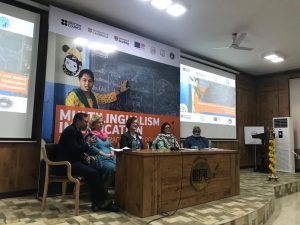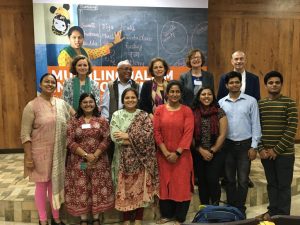
Jeanine Treffers-Daller (University of Reading)
How can we create learning environments that allow multilingual children to give full expression to their capacity to learn? This was the key question that was discussed in Hyderabad at the final dissemination event of the ESRC/DFID funded project on Multilingualism and Multiliteracy in primary schools in India (Multilila), which took place at the English and Foreign Languages University in Hyderabad (India) from 10-12 February 2020, organised by Dr Lina Mukhopadhyay from EFL-U and Amy Lightfoot from the British Council.

Dr Debanjan Chakrabarti (British Council India), Professor Victoria Murphy (Oxford), Professor Jeanine Treffers-Daller (Reading), Dr Praggya Singh (Central Board of Secondary Education in India) and Professor Paul Gunashekar (EFL-U, Hyderabad).
It has been known for many years that multilingual children in primary schools in India do not always benefit from being multilingual in the same way as children in other contexts. The Multilila project was set up to discover the reasons why this is the case and develop recommendations for practitioners in schools, as well as local, regional and national policy makers. This four-year project is now close to completion: The 2500 children who took part completed 14 different tasks focusing on language and literacy skills in English and school languages, maths, cognitive skills. The children came from low socio-economic backgrounds and attended schools in slum and non-slum areas in Delhi, Hyderabad (Telangana) and Patna (Bihar).
Dr Praggya Singh from the Central Board of Secondary Education in Delhi explained that many children in India are in English-medium education because the parents believe that knowledge of English will give children a headstart in life. The outcomes of the project showed that this was not the case for the low SES children in the project. Professor Ianthi Tsimpli (Cambridge), who leads the Multilila project, explained that children who were in schools where the home language was used as a medium of instruction were better at solving mathematical word problems. For this type of maths problem, children need to extract the underlying mathematical operation from a story. This is difficult if the school language is English, as this is not spoken at home in low SES families. Ianthi concluded: “The results from the project show that children are more successful in maths, and that their knowledge of language and literacy (English and home language) is equally good if English is taught as a subject but is not medium of instruction.”

Multilila team: Backrow: Dr Lina Mukhopadhyay (English and Foreign Languages University, Hyderabad), Amy Lightfoot (British Council India), Professor Ajit Mohanty (Jawaharlal Nehru University, Delhi), Professor Ianthi Tsimpli (Cambridge), Professor Jeanine Treffers-Daller (Reading), Professor Theo Marinis (Reading/Konstanz). Front row: Shravasti Chakravarty, Joshi Mesuram, Abhigna Reddy, Anusha Balasubramanian, Vasim Tamboli and Joshua Reddy
Another key finding of the project is that children who speak more than one language at home had higher scores in problem solving and working memory tasks. During the panel discussion with Language-in-Education policy makers, facilated by Dr Debanjan Chakrabarti from the British Council India, Professor Jeanine Treffers-Daller (Reading) explained that this is likely due to the fact that multilingual children frequently switch between languages: this “gymnastics for the mind” gives them an advantage in non-linguistic cognitive tasks, such as problem solving and tasks which place heavy demands on working memory.
Teachers in English-medium schools were found to use more than one language in the classroom to facilitate learning. Using English only was not an option in most of the classrooms due to low levels of knowledge of the language. As Professor Theo Marinis (Reading/Konstanz) put it in his summary of the views of the teachers: “Schools do not need to choose between English and the regional language. They can use both in the classroom.”
The 180 teachers who attended the dissemination event overwhelmingly supported the recommendations from the Multilila project that the children’s home languages should be used in the classrooms to support learning. They also said that multilingual teaching materials and multilingual assessments were urgently needed to measure students’ achievements. This view was also supported by Dr Professor Victoria Murphy (Oxford), who gave a keynote address at the event on the global proliferation of English-Medium Education (EMI). Victoria explained that EMI can work, but only if key conditions for its successful implementation are fulfilled. These include: high English proficiency levels of teachers and students and pedagogical practices that support student-centred learning.
The challenge for India is to create the environments in which successful learning through multiple languages can take place, because an English only approach does not work for children with low SES. New approaches which include story tellings in multiple languages are already being used in primary schools, explained Professor Paul Gunashekar from the English and Foreign Languages University in Hyderabad. Teachers present at the event provided many examples of excellent practice that is being shared with other practitioners through the Multilila website. The information will also be fed into the consultation process on the National Education Policy 2020, which will be released in December this year.
Examples of good practice in working with Indian children should be shared with teachers and policy makers in the UK who are interested in improving the teaching of learners with English as an Additional Language (EAL) in the UK. Many of these speak Indian languages (Punjabi, Telugu and Urdu).
The Multilila project is led by Professor Ianthi Tsimpli, with the following Co-investigators: Dr Suvarna Alladi (NIMHANS, Bangalore), Dr Lina Mukhopadhyay from EFL-U, Professor Theo Marinis (Reading/Konstanz), Professor Minati Panda (Jawaharlal Nehru University in Delhi) and Professor Jeanine Treffers-Daller (Reading).
For more information visit: https://www.mam.mml.cam.ac.uk/

